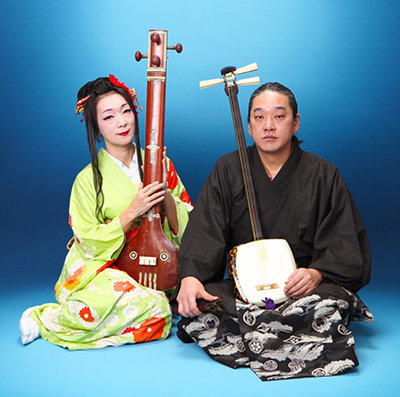 Thursday February 23rd at 6:30 pm
Thursday February 23rd at 6:30 pm
Rolex Learning Center Forum
Hisao Suginaka (shamisen)
Yuko Sarya (dance, singing and tanpura)
Music, dance and singing: Soubugen is an original project created by two Japanese artists from Hokkaido, Japan’s northern island. He is a shamisen player (Japanese lute) while she is a dancer, singer and plays tanpura (a kind of sitar). Together, they offer a dialogue between modernity and tradition.
THE MUSICIANS:
Musician Hisao Suginaka was literally born with a shamisen in his hands. He handles with virtuosity this Japanese traditional instrument, alternately with thoughtfulness as a geisha in a tearoom, and with spirit as a bluesman in a street corner of New Orleans. Before founding Soubugen with Yuko Sarya, he improved in the art of Tsugaru shamisen during seven years. Amid his most fervent admirers is Don Davis, the composer of the mythical “Matrix” trilogy.
Since her youngest age has Yuko Sarya studied Japanese traditional dance (Nihon Boyou). Before founding Soubugen with Hisao Suginaka, she danced during eight years at the Theater Hyousetunomon in Sapporo. In 1997, she perfected the technique of tanpura with famous Indian master Dinesh Chandra Dyoundi.
THE INSTRUMENTS:
The shamisen is an instrument of Chinese origins that was introduced in Japan during the middle of the 16th century. It is a lute whose squared resonance chamber is traditionally built in sandalwood and covered with cat or dog skin. The neck is long and thin, without shrink rings and with three strings (hence the name of the instrument, which literally signifies “Three tasteful strings”). There are three main chords: the “honchochi”, the “ni agar” and the “san sagari”. Each chord brings a slightly different feeling to reflect the musical piece’s atmosphere and to express the differences between the genres and thus varying the Pieces. Le Tsugaru shamisen is a folk Japanese musical style played on several regional variants of shamisen. More rhythmic than the classical shamisen, it comes from the Tsugaru area, Aomori prefecture in the north of Honshū, Japan’s main island.
Tanpura designates a family of long neck lutes widespread in China, Uzbekistan, Kazakhstan, India, Afghanistan, Iran, Iraq, Azerbaïdjan, Kurdistan, Tadjikistan, Turkey, Armenia, and the Balkans. By its form, the tanpura is close to the sitar but only contains one resonance chamber made of calabash (tumba),pumpkin or scooped out sold wood, and no shrink rings or sympathetic strings. It is composed of a hollow neck and a sound board, generally made of tun, teak or jackfruit wood.